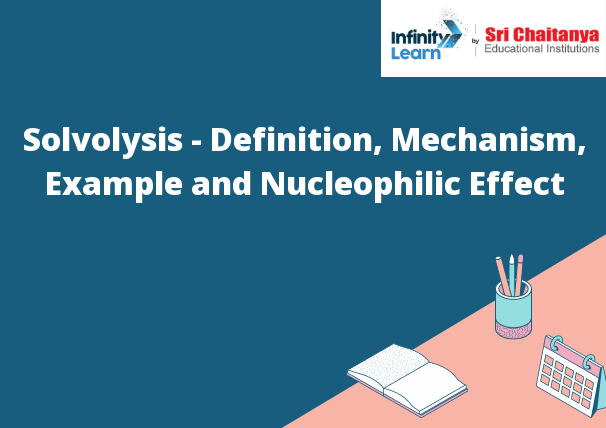Table of Contents
What is Solvolysis Reaction? ; Common Examples of Solvolysis
A solvolysis reaction is a type of chemical reaction in which a solute molecule (the solvolyte) is broken down by a solvent molecule. This type of reaction is often used to break down molecules into smaller pieces, making them easier to study.
Some common examples of solvolysis reactions include the breakdown of alcohols into aldehydes and ketones, the breakdown of carboxylic acids into esters, and the breakdown of amines into amides.

Classification of Solvolysis
Solvolysis is a type of reaction in which a molecule is broken down by the addition of a solvent. The solvent can be water, an alcohol, or another type of solvent. The reaction can be classified as either primary, secondary, or tertiary.
Hydrolysis
of sucrose
Hydrolysis is the process of breaking down a molecule into smaller pieces by the addition of water. Sucrose is a sugar molecule made up of two smaller sugar molecules, glucose and fructose. When sucrose is hydrolyzed, the water molecule breaks the sucrose molecule into glucose and fructose. These smaller sugar molecules can then be absorbed into the bloodstream to provide energy for the body.
Alcoholysis
In organic chemistry, alcoholysis is the process of breaking down an alcohol into its smaller constituent molecules, typically by the addition of water. This can be accomplished through either a physical or chemical process. In a physical process, the alcohol is simply mixed with water and the two substances are allowed to separate. In a chemical process, an acid or another catalyst is used to speed up the reaction.
Ammonolysis
The ammonolysis of an alkyl halide produces an ammonium salt and an alkyl radical.
Hydrolysis of Alkyl Halides (Tertiary and Secondary Haloalkanes)
The hydrolysis of tertiary and secondary haloalkanes results in the formation of alcohols and ketones, respectively.
The mechanism for the hydrolysis of tertiary haloalkanes involves the attack of the nucleophile (OH−) on the carbon atom adjacent to the haloalkane group. This produces a carbocation intermediate, which is then attacked by the hydroxide ion to form the alcohol product.
The mechanism for the hydrolysis of secondary haloalkanes involves the attack of the nucleophile (OH−) on the carbon atom adjacent to the haloalkane group. This produces a carbocation intermediate, which is then attacked by a water molecule to form the alcohol product.
The hydrolysis of haloalkanes can also occur using acids or enzymes.
Mechanism of Solvolysis Reaction
The solvolysis reaction of a tertiary alcohol in an aprotic solvent proceeds through a sequential process of proton transfer, tautomerization, and carbocation formation.
Formation of Carbocation
Carbocations are generally formed by the attack of a molecule of hydrogen on a carbon atom that is already bearing a carbon-carbon double bond.
The hydrogen atom abstracts a proton from one of the carbon atoms in the double bond, leaving a carbocation.
The position of the hydrogen atom in the original molecule determines the structure of the carbocation.
If the hydrogen atom is attached to the middle carbon atom in the double bond, the carbocation is a tertiary carbocation.
If the hydrogen atom is attached to one of the carbon atoms at the end of the double bond, the carbocation is a secondary carbocation.
If the hydrogen atom is attached to the carbon atom at the beginning of the double bond, the carbocation is a primary carbocation.
Attack of Nucleophile
A nucleophile is a molecule or atom that has a high affinity for electrons. When a nucleophile attacks an electron-deficient molecule or atom, it donates an electron to form a new, more stable molecule or atom. This process is known as nucleophilic substitution.
Stable Compound Formation
The reactants in a chemical reaction may combine to form a stable compound. In this case, the reaction is said to be “exothermic” because the combination of the reactants releases energy in the form of heat. The formation of a stable compound is often represented by a chemical equation in which the reactants are on the left-hand side and the product is on the right-hand side.
For example, the reaction of hydrogen and oxygen to form water is exothermic:
2H 2 (g) + O 2 (g) → 2H 2 O(g)
The formation of water is a very important reaction because it is necessary for life.
Nucleophilic Effect on Solvolysis
Nucleophiles can affect the rate of solvolysis by
1. Acting as a solvent
2. Acting as a nucleophile
3. Acting as an acid
1. When a nucleophile solvolyzes a substrate, the nucleophile can act as a solvent, which can increase the rate of the reaction.
2. The nucleophile can also act as a nucleophile, which can increase the rate of the reaction.
3. The nucleophile can also act as an acid, which can decrease the rate of the reaction.
Difference Between SN1 Reaction and SN2 Reaction
The main difference between the SN1 reaction and the SN2 reaction is that the SN2 reaction occurs in the presence of a nucleophile, while the SN1 reaction does not.








